10 Top Rated Motorcycle Hitch Carriers for 2021
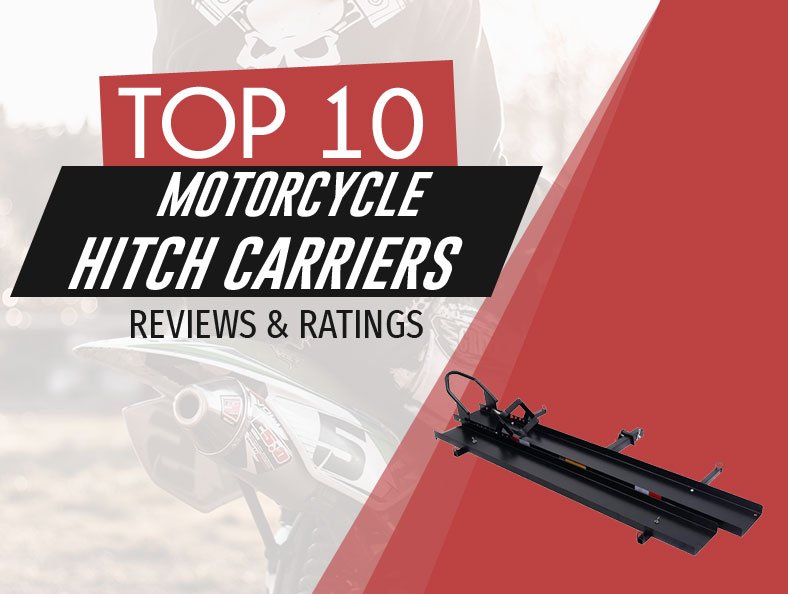
Road Racerz is proudly supported by our readers. Products purchased through links on our site may provide us a commission. Learn More
There’s a high chance you’ll have to transport your motorcycle from one place to another at some point. And while riding it to the location may be the simplest solution, you may not always be in a position to do that.
Transporting a motorcycle can be a bit of a challenging task, especially if you have a heavyweight motorcycle. A motorcycle hitch carrier is probably the most straightforward and efficient solution to the problem, regardless of the bike you have.
We’ve reviewed the best models and also included a little buyer’s guide to help you choose the right for your motorbike.
10 Highest Rated Motorcycle Hitch Carrier Reviews
| PRODUCT | FEATURES | |
|---|---|---|
Goplus 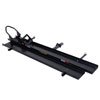 | Goplus Features: Powder coat finish, durable, rust-resistant construction Capacity: 600 lbs | Check Price |
TMS 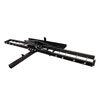 | TMS Features: Powder-coated stainless steel, resistant to scratches and dents Capacity: 500 lbs | Check Price |
Best Choice Products 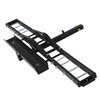 | Best Choice Products Features: Anti-tilt, easy to install and use Capacity: 500 pounds | Check Price |
Direct Aftermarket 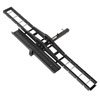 | Direct Aftermarket Features: Precise instructions, convenient and easy loading Capacity: 500 pounds | Check Price |
MotoGroup 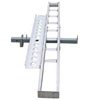 | MotoGroup Features: Either side loading, rust-free Capacity: 400 pounds | Check Price |
ECOTRIC 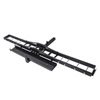 | ECOTRIC Features: Easy assembly, powder-coating Capacity: 500 lbs | Check Price |
VersaHaul 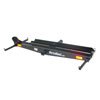 | VersaHaul Features: Durable black finish, no wobbling Capacity: 500 lbs | Check Price |
Black Widow 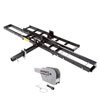 | Black Widow Features: Easy-to-install ramp, durable construction Capacity: 500 pounds | Check Price |
XtremepowerUS 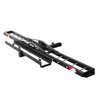 | XtremepowerUS Features: Steel construction, easy installation Capacity: 500 pounds | Check Price |
Raider 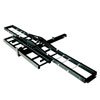 | Raider Features: Easy-to-use loading ramp, secure bolt-in clips included Capacity: 500 pounds | Check Price |
Goplus – Heavy Duty
This heavy-duty carrier is made of solid steel and is strong enough to carry all kinds of motorcycles. Also, the steel is impermeable, which means it won’t rust or corrode if you use it in the rain.
It’s meant for carrying light and heavy motorcycles, supporting up to 600 pounds. However, you’ll have to pay attention to your speed because it’s recommended you stay below 55 mph.
It comes with a ¾’’ hitch pin, mounting with your vehicle’s 2’’ receiver. Also, it’s 79’’ long and has an adjustable wheel stop that works as a stabilizing wheel chock.
This one has two quick-release locks that help you to secure your motorbike. It’s safe to use on bumpy roads, as long as you don’t drive too fast.
PROS
- Powder coat finish
- Carries up to 600 lbs
- Durable, rust-resistant construction
CONS
- Requires two people to install
TMS – Anti-tilt
TMS is one of the most reliable carriers if you’re looking to haul your dirt bike or scooter. Its sturdy construction and design allow safe, anti-tilt transportation.
It’s made of heavy-duty steel, so it’s nearly impossible to break and damage. The frame is quite durable and also powder-coated to resistant fading, scratching, chipping, and showing any signs of wear as quickly.
This one is designed to fit a 2’’ square receiver for II, III, IV, and V class trailer hitches. It has a dual-sided loading ramp that makes it easy to load your motorcycle in no time.
Another thing worth noting is the anti-tilt locking device and tie downsides. It’s designed to prevent wobbling, delivering reliable performance at all times.
PROS
- Powder-coated stainless steel
- 500 lbs capacity
- Resistant to scratches and dents
CONS
- A bit tricky to assemble
Best Choice Products – Versatile
If you have several motorcycles and are in need of a more versatile hitch carrier, you may want to consider this one. This one measures 76×7 inches in total, which makes it a good fit for most vehicles.
It’s easy to assemble and install thanks to the instructions it comes with. Plus, the construction is quite simple to understand and fit together.
It comes with a self-storing ramp that you can install on either side. This allows you to choose based on how it would be easier for you to load and unload the bike.
Also, this one comes with an anti-tilt locking device that prevents rattling and wobbling. It has tie-down sites on each side of the track for some added security during transportation.
It’s designed to carry motorcycles that weight up to 500 pounds.
PROS
- Anti-tilt
- For II, III, IV, and V class receivers
- Easy to install and use
CONS
- A bit narrow
Direct Aftermarket – Easy Assembly
This quality-built carrier is ideal for frequent hauling of motorcycles that are up to 500 pounds heavy. It’s made to carry dirt and sportbikes, scooters, and other similar vehicles.
It’s made of weather-resistant epoxy powder-coated tubular steel. The construction is heavy-duty and resistant, which allows you to use the carrier often and across all distances.
Also, it has a ramp built so that you can load your motorbike from either side, depending on what’s the most convenient for you.
Keep in mind that the rack is some 75’’ wide and 33’’ long.
The ramp is 5 inches wide and 38 inches long. Also, this one is compatible with class III or IV hitch, requiring a 2’’ square hole.
PROS
- Precise instructions
- Convenient and easy loading
- Durable, powder-coated frame
CONS
- Trailer hitch pin not included
MotoGroup – Anti-wobble
If you plan to transport your bike across a bumpy road, you need an anti-wobble carrier like this MotoGroup. Its maximum capacity is 400 pounds, fitting in 2’’ square class II, III, IV, and V trailer hitch.
It comes with an anti-tilt hitch locking device that prevents it from rocking. It’s designed to provide a more stable and secure ride.
It’s made of lightweight aircraft aluminum, weighing only 36 pounds in total. You probably won’t have any struggles with installing this one and loading your motorcycle.
However, there’s also the grey powder-coated steel sub-frame for some added durability and reliability.
The frame is resistant to rust and corrosion, so you can freely use it in the rain as well.
PROS
- Either side loading
- Rust-free
- Secure, anti-wobble design
CONS
- Not the sturdiest nuts and bolts
ECOTRIC – Durable
This heavy-duty, sturdy carrier is designed to carry scooters, off-road, and motocross bikes. It features a durable steel frame that makes the entire process secure and more reliable.
This one is easy to install and use regardless of the bike you have as long as it’s not heavier than 500 lbs. It measures 76×7 inches in total, while the main hitch tube is 18’’ long. The loading ramp measures 38.5×4.75 inches.
It comes with a loading ramp that makes it easier to load and unload the motorbike. Plus, the powder-coated steel construction won’t bend or dent so easily. It’s durable and made to withstand frequent use with ease.
On top of that, it comes with an anti-tilt locking device but no trailer hitch pin.
PROS
- Easy assembly
- Powder-coating
- For II, III, IV, or V trailer hitch
CONS
- Trailer hitch pin not included
VersaHaul – Black
VersaHaul has a capacity of 500 lbs and is built to fit 2’’ class III and IV hitch receivers. It’s ideal for transporting motorcycles and dirt bikes as it also includes a loading ramp.
It comes with four eyelet tie-down points that are made to secure your bike. This allows a safer ride, preventing wobbling even on bumpy roads.
Its integrated hitch tube is rated at 1/3 the vehicle hitch towing capacity. One thing to keep in mind is that you shouldn’t go over its 3,000 towing weight.
Also, keep in mind that it’s made of steel, so it’s a bit heavy.
This means you’ll maybe need another person to help you install it onto your vehicle. The heavy-duty steel construction has a black paint finish that’s durable and resistant to corrosion.
PROS
- Durable black finish
- No wobbling
- Loading ramp included
CONS
- Heavy to install without some help
Black Widow – Powder-coated Steel
This Black Widow motorcycle carrier is durable and ideal for frequent use. The steel construction is powder-coated, meaning that it’s resistant to corrosion and chipping.
The hitch-mounted folding carrier is suitable for motocross dirt bikes as well. It comes with a self-storing ramp that you can attach to the carrier during transport.
Its track measures 6’ 3.75’’ x 6.875’’ while the ramp measures 3’ 9.5’’. The overall maximum capacity is 500 pounds.
The ramp is simple to install since you can attach it to either side, depending on what’s easier and more convenient for you.
Keep in mind that it includes a 5/8’’ hitch pin, an anti-rattle device, and a folding hitch adapter. It’s safe to use on bumpy roads, keeping your motorcycle from wobbling and tilting.
PROS
- Easy-to-install ramp
- Durable construction
- Powder coating
CONS
- It weighs 62 pounds
XtremepowerUS – Portable
This may be the best choice if you’re looking for a more portable hitch carrier. It has a loading ramp that attaches to the carrier next to the track, allowing easier transport.
It fits any 2’’ square receiver and class III, IV, or V trailer hitch. It’s an ideal choice for motorcycles, off-road bikes, and scooters.
It’s made out of heavy-duty steel tubing, so it’s pretty durable, strong, and reliable. It has a maximum capacity of 500 pounds.
Another thing worth noting is that it comes with an anti-tilt locking device that helps to prevent wobble. It provides secure transport even if you’re riding across bumpy roads.
This one is rather simple to install thanks to all the mounting hardware that’s included. The process doesn’t require any professional tools.
PROS
- Steel construction
- No wobbling or tilting
- Easy installation
CONS
- Not for high speed
Raider – Easy-roll
Raider is a good choice if you need a hitch carrier to use frequently and with different motorcycles. It’s easy to install and use, having a capacity of 500 pounds.
It’s a secure way of transporting your motorcycle as there’s no tilting or wobbling. You probably won’t have any issues riding across bumpy roads as well.
All you have to do is roll the bike up the ramp and into the carrying channel. Secure the tires with the bolt-in clips that are included. Once it’s in place, you can unhook the ramp and secure it on the frame.
Keep in mind that the carrying channel measures 5’’ x 76’’ in total. Make sure to check if this fits your motorbike.
PROS
- Easy-to-use loading ramp
- Secure bolt-in clips included
- No wobbling
CONS
- Easy to scratch
What to Consider in Buying a Motorcycle Trailer Hitch for Hauling
Material
It’s always important to think about the material because it affects durability, safety, and overall ease of use.
The most popular options are aluminum and steel. The two are strong and durable, but both have their own advantages and drawbacks.
Steel is extremely strong and reliable, so it’s often used to transport heavy motorcycles. If you have a heavier bike, you can be sure that a steel hitch will be able to handle it. However, keep in mind that steel hitches are bulky and heavy.
Aluminum is best for lighter motorcycles because it may bend or break under pressure. But, it’s a lightweight material, so you probably won’t have any issues with installation.
Dimensions
Most hitch carriers are compatible with nearly all motorcycles when it comes to dimensions. However, you should always check this so that you can be sure that the two fill fit.
The last thing you want is a hitch carrier you can’t use because your motorcycle is too big for the rack. Your tires have to fit inside the channel in order for the transportation to go on safely.
Although most carriers can be modified a bit, there won’t be anything you can do to fit a motorcycle that’s too big for the carrier you purchased.
Mount
A motorcycle hitch carrier attaches at the back of your car, allowing you to safely transport your bike. Although this sounds pretty simple, the process can sometimes be a bit complicated.
It usually depends on the size and weight since heavier carriers are trickier to install. In this case, you’ll maybe need another person to assist you.
The best way of finding out the hitch class of your vehicle is to check its user manual. Knowing this detail will make it easier to find the best fitting carrier so that you install it with ease.
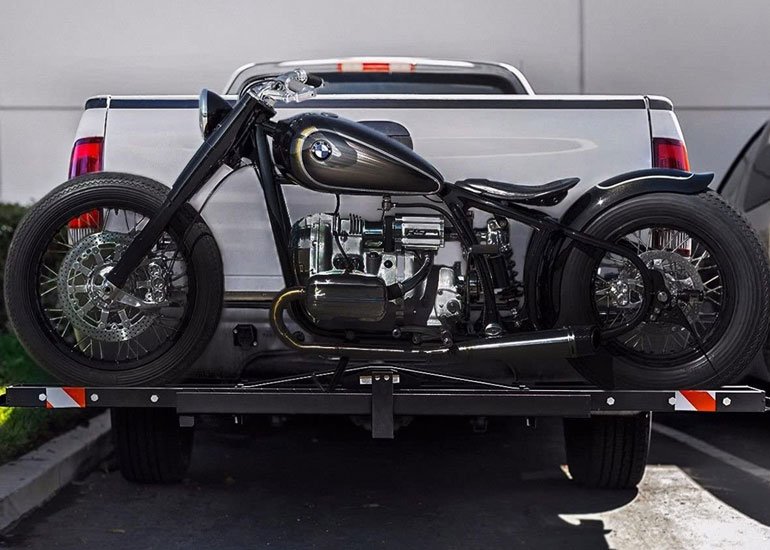
Ramp Length
The length of the ramp is another thing you should consider. Keep in mind that a ramp is something nearly all carriers come with. It’s because there’s not really a way to load or unload your motorcycle without it.
But, not all ramps are the same, which is why you should check the measurements and weight limit. You want your bike to fit and go across the ramp safely.
It should be as long as possible, especially if you’re planning to load/unload the bike on your own. A longer ramp makes the process much easier.
More Reading: 8 Top Rated Ramps for Motorcycles in 2021
Hitch Receiver
The hitch receiver is one of the most critical components to pay attention to. It’s something you should double-check if it fits your vehicle regardless of the carrier you’re interested it.
Luckily, these components are usually standard, which makes it easier to make the right decision. There’s a high chance that it will fit, but don’t rely on just that.
Take the time to check the dimensions as well as the weight it can sustain. You don’t want to assume it will fit only to find out that it doesn’t.
Wheel Stop
Carrying your motorcycle this way is simple and effortless, but can be quite dangerous. To prevent any accidents and incidents, you should find the best way to secure the bike in place.
View the top wheel chocks here.
A wheel stop is designed to secure the vehicle in place so that it doesn’t slide from the carrier while on the road.
Although there are other safety features as well, a wheel stop is among the most critical and handy ones. It’s simple to use and unlikely to fail you regardless of the motorcycle you have.
Sadly, not all carriers have a wheel stop, so make sure to check that.
Safety
Safety should be your priority when choosing a motorcycle hitch carrier. We probably don’t have to mention the damage from a carrier breaking under a motorcycle. For this reason, think about the safety of its construction parts.
Heavy-duty steel carriers are generally pretty safe because they’re durable and unlikely to break. Go for a product that doesn’t allow movement that would damage your vehicle. Also, make sure that it’s sturdy and won’t break.
Make sure that it has tie-downs or another similar feature that allows you to secure the motorcycle in place. Also, it should have a long loading ramp to make loading and unloading easier and safer.
Weight Capacity
You should know how heavy your bike is so that you can find a compatible carrier. Both your car and carrier have to be able to withstand the weight of the motorbike.
Luckily, manufacturers always mention weight capacity because it’s such a critical factor. If you can’t find the info on this, you should either call the manufacturer to check or move on to the next product.
Loading a motorbike on a carrier that can’t handle its weight would result in a disaster. The carrier would probably bend or break, damaging your bike.
Vehicle’s Weight
This is another thing you should check since the entire process depends on it. Make sure that its hitch can handle the weight you’re planning for it to carry.
There’s more to this than just the weight of your motorcycle. Think about the weight of the carrier as well.
The combined weight of both the carrier and your motorbike should not exceed the vehicle’s tongue weight. Things could break, and you’ll probably damage both vehicles.
Compatibility
As we mentioned, it’s important for your hitch carrier to be compatible with both your bike and car. The best way to ensure this is to consider all the critical buying factors we discussed.
Think about the weight capacity of the carrier but also of your car’s hitch. Although most carriers are universal, you want to be sure that it will fit your vehicles.
Luckily, most manufacturers list all the details concerning compatibility. If you have a doubt, you can always call the company and check with them.
Compatibility is an important factor, so don’t skip double-checking this part.
Cost
Hitch carriers can be both affordable and expensive. In most cases, it depends on the brand, materials, quality of manufacturing, safety features, overall durability, and a few other things.
Also, load capacity is another thing that affects the overall cost. Those that can carry heavier bikes are usually more expensive than those made for lightweight vehicles.
The price always varies depending on the features included. Things like safety tie-downs, wheel stops, and long ramps are always on a more expensive side. Also, powder-coated models are almost always pricier than those that don’t have this protective layer.
Ease of Installation
In most cases, you’ll find instructions included with the product. However, these instructions can sometimes be tricky to follow.
Naturally, heavier carriers are more challenging to install. You may even need an extra pair of hands to put everything together.
The weight of the hitch carrier affects the ease of installation the most. Check it to see how easy the carrier is to manipulate and assemble.
Luckily, you can find plenty of online tutorials on how to install pretty much any motorcycle hitch carrier.
Multiple Capacity
Multiple capacity is a detail you should check out if you plan on carrying more than one motorbike. Carriers that are designed to transport several motorcycles have a higher weight capacity rating.
However, there are other things you should consider as well, such as a wheel stop. Safety is always an important factor, even more so when the load is bigger.
One thing to keep in mind is that you probably won’t be able to carry several heavy-duty bikes. Carriers with multiple capacity are designed for dirt bikes and other similar vehicles.
What is a Motorcycle Hitch Carrier?
A motorcycle hitch carrier is a transporting device that connects to your car, SUV, van, or truck, making it easy to transport your motorbike.
It’s a different method than, for example, transporting via a trailer. The difference is in the fact that a hitch carrier carries your bike above the road.
The entire system is pretty secure, relying on more than just straps to hold the motorcycle in place. Most models include tie-downs, a wheel stop, and a few other safety features.
It’s a clever and secure design as long as you choose the right carrier that fits your motorcycle and the vehicle you install it on.

Different Classes of Hitch for Cars, Trailers, and More
Class I
Class I one is meant for tongue capacity of up to 300 pounds. It’s suitable for vans, SUVs, pickup trucks, sub-compact cars, and sedans.
Although its weight capacity doesn’t sound like much, these are quite versatile and can carry almost any light motorbike. Loading and unloading are effortless as well.
Class II
Class II is for a tongue capacity of 525 pounds. It connects to pickup trucks, SUVs, sedans, and vans, but not recommended for sub-compact vehicles.
Sub-compact vehicles probably wouldn’t be able to pull such a load, which is why you should avoid trying. These motorcycle hitch carriers are also versatile and easy to use.
Class III
Class III models have a load capacity of up to 1,200 pounds. Keep this in mind when trying to figure out what type of vehicle can pull it along.
You can use it if you drive a pickup truck, a van, or an SUV. As you noticed, it’s too heavy for a sedan.
Class IV
Class IV is quite an impressive group of hitch carriers. A hitch carrier in this class is pretty heavy-duty, and you have to be careful when it comes to selecting a vehicle to pull it.
It can carry up to 2,700 pounds, which is quite a lot. For this reason, it’s only recommended for pickup trucks and no other vehicles.
Class V
Class V hitch carriers are equally as impressive, having a weight capacity of up to 2,700 pounds. You won’t be able to pull such a model with your sedan or an SUV.
Only a pickup truck could pull a class V carrier, which is something to keep in mind if you need this much weight capacity.
Benefits of a Motorcycle Carrier
The most significant benefit is the ability to transport your motorbike from one point to another. Also, these are pretty versatile and especially convenient if you don’t have a flatbed van or truck.
Carrying your motorbike on a hitch carrier frees up space inside your van or truck for other cargo you may have to carry.
Plus, transporting your bike this way is much easier and safer than on a trailer. Trailers can be tricky to drive with, especially if you don’t have any experience.
Needless to say, that hitch carriers are much more affordable and cost-effective than trailers.
Installation Steps
The first thing you should do is read the instructions included. If they’re confusing or you didn’t get any, you can do the following:
- Get a 17mm wrench and a 13mm wrench
- Use the supplied bolts to connect the support brackets to the hitch bar
- Place the motorcycle rack between the two brackets before you secure with nuts, washers, and bolts
- Slide the anti-tilt bracket over your car’s hitch bar
- Slide the rack into the carrier hitch and secure with a hitch pin
- Attach the ramp with a nut and bolt included
Frequently Asked Questions
What accessories do I need?
Most of what you need is already included in the package. However, a few other safety accessories may be useful, especially if you’re transporting a heavy-duty motorbike.
Look for tie-down straps, soft loops, strap hooks, and hitch pins to further secure your motorbike in place.
How to secure a hitch carrier?
Use soft loops to tie the bike to the ramp. In most cases, four soft loops will be enough for you to secure the handlebars and another two stable parts in the back.
Use tie-down straps and other accessories we mentioned to secure the motorbike in an upright position so that it doesn’t wobble or tilt during transportation.
Are these safe?
These are typically built to perform safely. However, you should be aware of the quality of the carrier as well as its compatibility with your vehicles.
Also, you should be careful with the installation process because an improperly installed product can’t perform as well.
What is the tongue weight capacity?
As we explained, tongue weight capacity is your vehicle’s hitch carrying capacity. It’s not about how much weight a carrier can handle, but how much can the vehicle that’s pulling it withstand.
It’s an important factor that you shouldn’t overlook if you want safe and reliable performance.
Conclusion
Transporting a motorbike from one place to another is always stressful. We all know that there’s always an underlying fear of something going wrong.
And, the best way of avoiding as much of this stress as possible is to go for a reliable hitch carrier. These devices are built with quality and safety in mind. As such, they’re among the best options when it comes to transporting motorbikes regardless of model and weight.
Still, you have to keep in mind the important buying factors we discussed so that you can find the carrier that fits you the best.
















